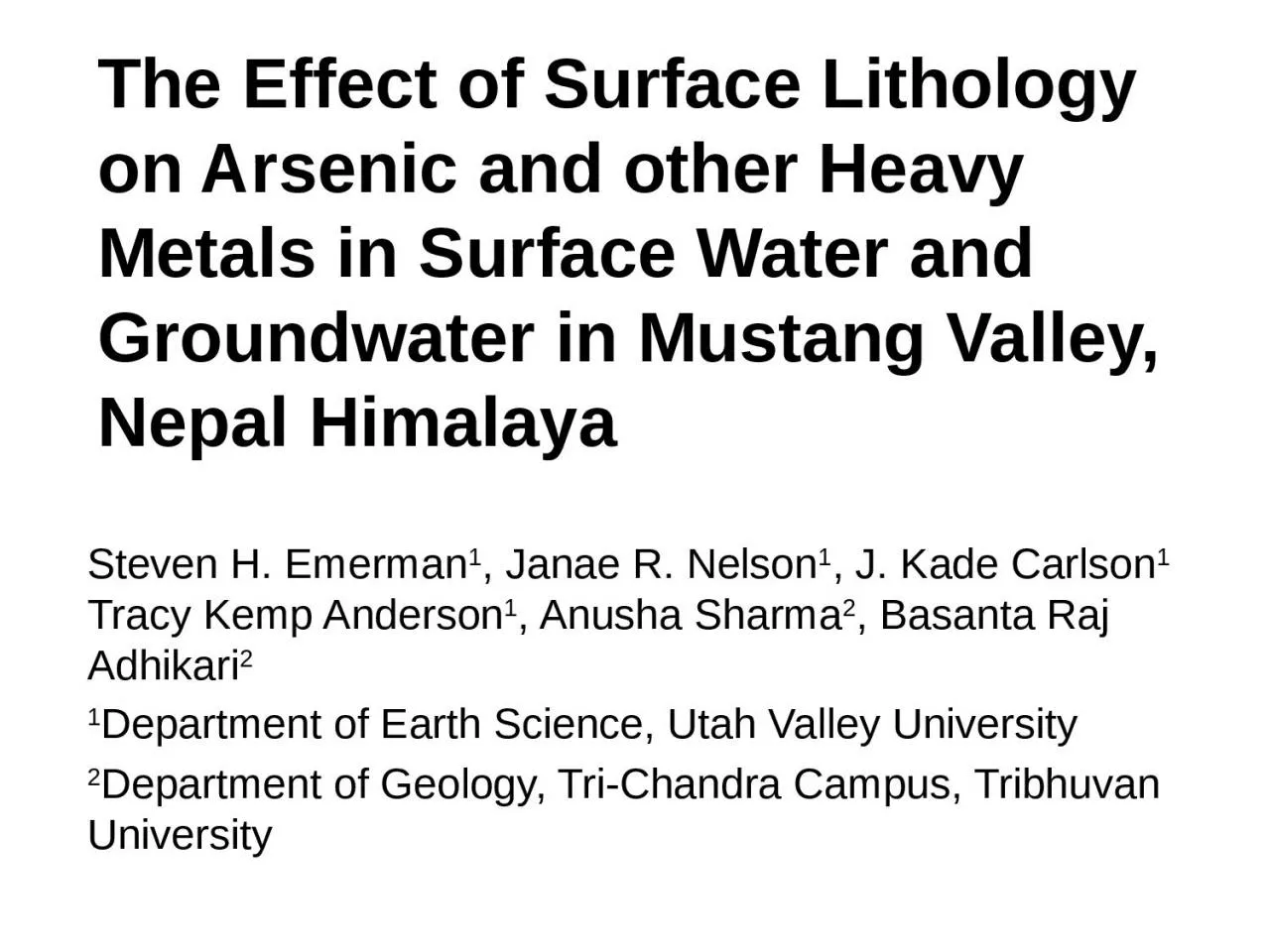

Steven H Emerman 1 Janae R Nelson 1 J Kade Carlson 1 Tracy Kemp Anderson 1 Anusha Sharma 2 Basanta Raj Adhikari 2 1 Department of Earth Science Utah Valley University ID: 1037659
Download Presentation The PPT/PDF document "The Effect of Surface Lithology on Arsen..." is the property of its rightful owner. Permission is granted to download and print the materials on this web site for personal, non-commercial use only, and to display it on your personal computer provided you do not modify the materials and that you retain all copyright notices contained in the materials. By downloading content from our website, you accept the terms of this agreement.
1. The Effect of Surface Lithology on Arsenic and other Heavy Metals in Surface Water and Groundwater in Mustang Valley, Nepal HimalayaSteven H. Emerman1, Janae R. Nelson1, J. Kade Carlson1 Tracy Kemp Anderson1, Anusha Sharma2, Basanta Raj Adhikari21Department of Earth Science, Utah Valley University2Department of Geology, Tri-Chandra Campus, Tribhuvan University
2.
3. Dominant Paradigm for Arsenic Contamination of Groundwater in South AsiaIn strongly reducing conditions of thick sedimentary package, micro-organisms break down iron oxyhydroxides for energy (reductive-dissolution model).This model assigns no responsibility to any human activity.
4. Competing Sulfide-Oxidation Model for Arsenic Contamination of GroundwaterOxidation of sulfide minerals results in release of co-precipitated arsenic.Sulfide oxidation could result from overpumping of aquifers.
5. Comparison of Fluvial As between Higher Himalayan and other Zones
6. Fluvial Recharge ModelAll of the existing models are thermodynamically plausible, but the kinetics are too slow.Groundwater is recharged by losing streams with elevated arsenic due to accelerated erosion caused by monsoon climate, tectonic uplift, deforestation and rangeland degradation.
7. Why does Accelerated Erosion cause Elevated Arsenic in Surface Water?Accelerated erosion results in higher concentration of dissolved solids in overland flow.In rapid overland flow, the large As oxyanion has too much kinetic energy to attach to sorption sites and not enough residence time at a sorption site.
8. ObjectivesDocument the occurrence of elevated arsenic in the three major tectonic valleys of Nepal Himalaya (Kathmandu Valley, Pokhara Valley and Mustang Valley) with particular attention to sources of drinking waterTest the fluvial recharge, reductive-dissolution and sulfide-oxidation models in these tectonic valleys
9.
10.
11. Methods: Mustang ValleyWater samples were collected from 24 streams, four canals or pipes fed by streams, five public faucets fed by streams, 10 springs, and 14 public faucets fed by springs.There are no wells in Mustang Valley.pH, electrical conductivity and temperature measured on-siteAs, transition elements (Fe, Cu, Ni, Co, Mn, Zn, Cr) and SO4 measured with Hach DR-2700 Portable Spectrophotometer
12.
13.
14.
15.
16.
17.
18. Nepal Interim Arsenic Standard (As = 0.05 mg/L) was exceeded in: 31% of surface water sites63% of groundwater sitesall nine public faucets in Lo-ManthangAll other public faucets in Mustang Valley did not exceed Nepal Interim Arsenic Standard.
19.
20.
21.
22.
23.
24.
25.
26. Tentative ConclusionsArsenic contamination of groundwater in south Asia is not confined to the Ganges-Brahmaputra floodplain.The dominant reductive-dissolution model is not supported by the geochemical data in the Himalaya.Arsenic contamination of groundwater in the Himalaya results from accelerated erosion.Arsenic contamination of groundwater in the Himalaya cannot be addressed without addressing the problems of deforestation and rangeland degradation.
27. AcknowledgementsCenter for Engaged Learning (UVU)Presidential Faculty Scholarly Activities Award (UVU)Department of Earth Science (UVU)Institute for Professional Engagement (UVU)Student Scholarly and Creative Opportunities (SCOP) Award (UVU)Student Scholarly Activities Committee (SAC) Award (College of Science and Health, UVU)
28. Thanks for listening! Any questions?